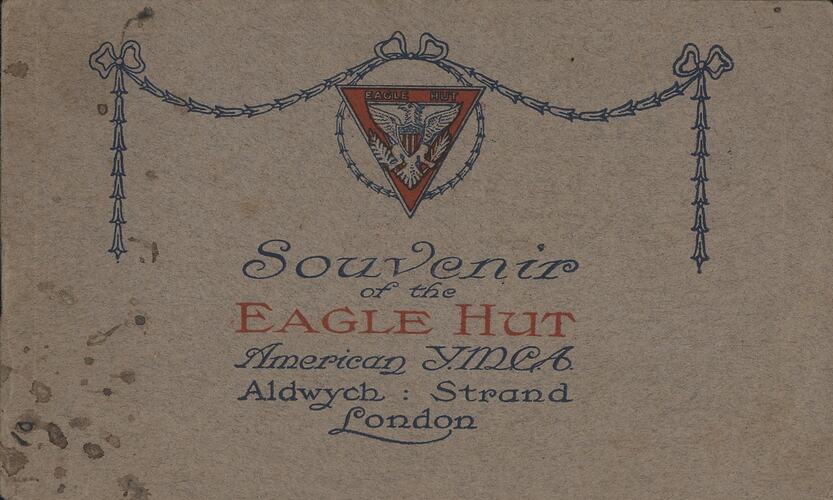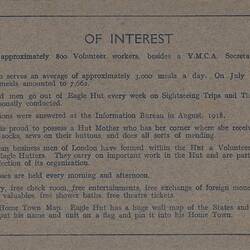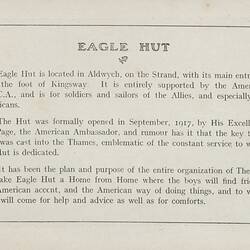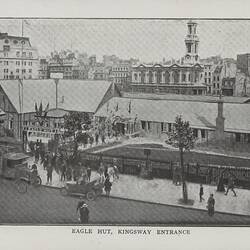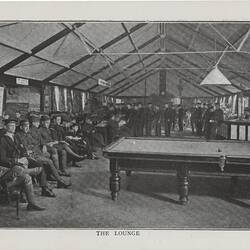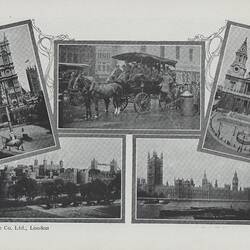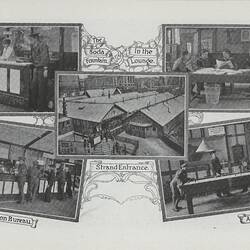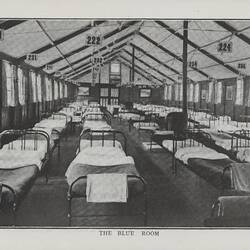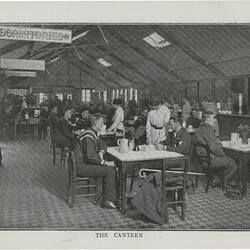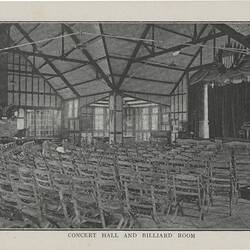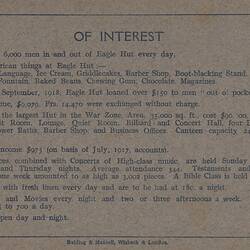Summary
Souvenir booklet of the Eagle Hut, located in Aldwych, on the Strand, in London, during World War I. The souvenir booklet contains a description of Eagle Hut and photographs of the premises and London landmarks. The photographs of London landmarks were taken by Photochrome Co. Ltd, London and the booklet as a whole was published by Balding & Mansell.
Eagle Hut was an American Y.M.C.A. (Young Men's Christian Association) inititative following the US declaration of war on Germany on 6 April 1917. US troops were soon arriving in England and preparing for offensives on the Western Front. Eagle Hut was opened within months, in September 1917, by the then American Ambassador, Dr Page. As well as supporting US troops passing through London, it also catered for other allied troops. It remained in operation until 25 August 1919.
According to the booklet, Eagle Hut offered a canteen, 'kit room', lounge, 'quiet room', billiard and concert hall, dormitories, toilets, 'shower baths', barber shop, business offices, money lending, religious services, entertainments and movies.
Eagle Hut was a 'Home from Home where the boys will find friends, the American accent, and the American way of doing things, and to which they will come for help and advice as well as for comforts.' The scale of the operation was huge: around 800 workers served 6,000 men daily; on one day alone - 4th July 1918 - 7,662 meals were served. Each week 600 men attend 'personally conducted' sightseeing parties and theatre parties. 279 beds were available. At 35,000 sq.ft, it was the 'largest hut in the War Zone Area'.
The 'distinctly American things at Eagle Hut' included ice cream, griddle cakes, boot-blacking stand, hash (ie. hash brown potatoes), bubbling fountain, baked beans, chewing gum, chocolate and magazines.
Physical Description
A souvenir booklet containing pages of black-and-white photographs and text printed in black and blue ink. Heavier grey paper cover printed in blue and red, featuring the YMCA logo. The images within the booklet depict the exterior, lounge, views of London, the entrance on the Strand, the soda fountain, shops & information bureau, the 'Blue Room' (full of iron beds), the canteen, and the concert hall and billiard room.
Significance
This booklet is significant as a record of troop recreational activities during World War I, and also as a source for early 20th century images of London. Organized recreational services for soldiers on leave were important both for troop morale and for limiting the misbehaviour of soldiers. The booklet would have reassured soldiers and their families about the quality of services provided while overseas.
It is claimed that during World War I the YMCA deployed over 25,000 staff in military units and bases in war zones, and organized morale and comfort operations across the world. (Wikipedia, 'YMCA') (They were not the only organization to do so - the Red Cross, for example, played a critical international role.) According to the National Heritage Museum (USA), General John J. Pershing (1860-1948) designated that the role of the YMCA was to provide amusement and moral welfare to the soldiers. The YMCA operated from 'huts' or 'canteens' on or near the war front, ranging from a tents to small buildings, which were re-purposed as clubs, theatres, gyms, or general stores, served refreshments such as coffee and doughnuts, gave out books and offered mail services to the soldiers. Women often worked there, undoubtedly adding to their appeal.
More Information
-
Collecting Areas
-
Acquisition Information
Purchase
-
Place Named
-
Place Named
-
Organisation Named
-
Format
Booklet
-
Inscriptions
Printed in black ink on the front of the booklet, bottom centre half: 'Souvenir / of the' Printed in red ink on the front of the booklet, underneath above text: 'EAGLE HUT' Printed in black ink on the front of the booklet, underneath above text: ' American YMCA / Aldwych: Strand / London'
-
Classification
-
Category
-
Discipline
-
Type of item
-
Overall Dimensions - Closed
177 mm (Width), 106 mm (Height)
-
References
Information on YMCA from (Wikipedia article 'YMCA', [Link 1] accessed 9/2/2012 Also: National Heritage Museum, USA, web site [Link 2] accessed 9/2/2012
-
Keywords
Souvenirs, Youth Organisations, American Military Forces, Americans, Recreation Activities, Volunteers, World War I, 1914-1918, Soldiers' Comforts
